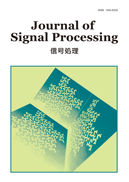
- |<
- <
- 1
- >
- >|
-
Yasuteru Hosokawa, Yoshifumi Nishio2020 Volume 24 Issue 1 Pages 1-9
Published: January 20, 2020
Released on J-STAGE: January 20, 2020
JOURNAL FREE ACCESSIn this paper, a cellular neural network using two kinds of cloning templates, which is a kind of modified cellular neural networks (CNN), is proposed and investigated. The structure of this system is almost the same as that of the conventional CNN. Namely, the only difference between the conventional CNN and the proposed system is the number of signal lines used for cloning templates. Therefore, the difficulty of IC implementation is almost the same. This system can carry out more complicated processing than the conventional CNN. Additionally, cloning templates of the conventional CNN can be applied to this system. As applications, five different cloning templates for image processing that can carry out complicated processing and a demonstration of an image-processing application are shown. In the demonstration, by using two cloning templates for the proposed system and three cloning templates for the conventional CNN, we demonstrate the extraction of numbers drawn with a hard-to-distinguish color in the background of postage stamps. On the other hand, oscillatory phenomena can be observed in the case of a periodic boundary condition and a symmetry-cloning template. In the case of the conventional CNN with a corresponding condition, oscillatory phenomena cannot be observed. The proposed system consists of two kinds of cells that cannot oscillate on their own. Namely, elements of the oscillator are shared among each other. In this point, the proposed system is of interest. Synchronization, quasi-synchronization and clustering phenomena are observed in the proposed system. The system is analyzed and the oscillation of the system is verified.
View full abstractDownload PDF (706K) -
Shahrzad Mahboubi, Indrapriyadarsini Sendillkkumaar, Hiroshi Ninomiya, ...2020 Volume 24 Issue 1 Pages 11-17
Published: January 20, 2020
Released on J-STAGE: January 20, 2020
JOURNAL FREE ACCESSIn this paper, we describe a robust technique based on the quasi-Newton method (QN) using an adaptive momentum term to train of neural networks. Microwave circuit models have strong nonlinearities and need a robust training algorithm for their neural network models. The robustness here means that practical solutions can be obtained regardless of the initial values. QN-based algorithms are commonly used for these purposes. Nesterov's accelerated quasi-Newton method (NAQ) proposed a way to accelerate of the QN using a fixed momentum coefficient. In this research, we verify the effectiveness of NAQ for microwave circuit modeling with high nonlinearities and propose a robust QN-based training algorithm with an adaptive momentum coefficient. The proposed algorithm is demonstrated through the modeling of a function and two microwave circuit modeling problems.
View full abstractDownload PDF (389K) -
Shengke Lin, Takashi Tsunakawa, Masafumi Nishida, Masafumi Nishimura2020 Volume 24 Issue 1 Pages 19-29
Published: January 20, 2020
Released on J-STAGE: January 20, 2020
JOURNAL FREE ACCESSIn this paper, we propose a method to improve a recognition performance of multiparty conversations by using both close-talk and throat microphones. Throat microphone is robust against external noise. However, its characteristics are much different from those of conventional acoustic microphone such as close-talk. Therefore, it is generally not suitable for a speech recognition because of acoustic mismatch between them. We tried to map a spectra of throat microphone to close-talk and estimate a clean speech by controlling weights of speech of each microphone. The proposed method was able to improve a performance of large vocabulary continuous speech recognition task for data on which utterance was superimposed manually and group discussion.
View full abstractDownload PDF (17111K) -
Yoshiki Tsukamoto, Masashi Takemura, Hiroshi Kubo2020 Volume 24 Issue 1 Pages 31-40
Published: January 20, 2020
Released on J-STAGE: January 20, 2020
JOURNAL FREE ACCESSThis paper proposes a doubly-selective channel simulator for underwater acoustic communications (UWACs), where doubly-selective environment corresponds to time and frequency selective channel environment. The proposed channel simulator can simulate severe doubly-selective environment and large signal frequency band-width to center carrier frequency ratio inevitable in UWACs environment owing to carrier frequency band sampling. First, this paper proposes a principle of the doubly-selective channel simulator for UWACs and its applications in discrete-time channel models. Next, this paper indicates performance bench-mark channel model in order to evaluate several wireless transmission technologies. Finally, computer simulation results confirm that the proposed doubly-selective channel simulator using the bench-mark channel model can simulate actual experimental environment of UWACs.
View full abstractDownload PDF (6933K)
- |<
- <
- 1
- >
- >|